Strategic Business Modeling for Teclo: Disruptive Innovation Response
VerifiedAdded on 2020/04/07
|11
|1935
|249
Report
AI Summary
This report examines Teclo's response to disruptive innovation, focusing on the application of Strategic Business Model Ontology (SBMO) to help the company overcome challenges. The analysis begins with the development of illustrative models of Teclo, assessing its current business strategy and model, and identifying the impact of disruptive technologies like the rise of cell phones. The report then uses a prescriptive model to analyze the changes, assess the competitive battle between Teclo and a new entrant, Cellco, and determine Teclo’s strategic choices. It details Teclo’s business model through a Strategic Dependency (SD) model, illustrating actor relationships and dependencies, including those with customers and stakeholders. The study explores the company’s strategic objectives, including efficiency drivers, lock-in, and innovation, and examines how changes in the market trigger alterations in Teclo’s business model, ultimately leading to a competitive battle. The report concludes by highlighting the importance of strategic modeling in understanding and reacting to changes in the business environment and the need for companies to be proactive in responding to opportunities and threats.
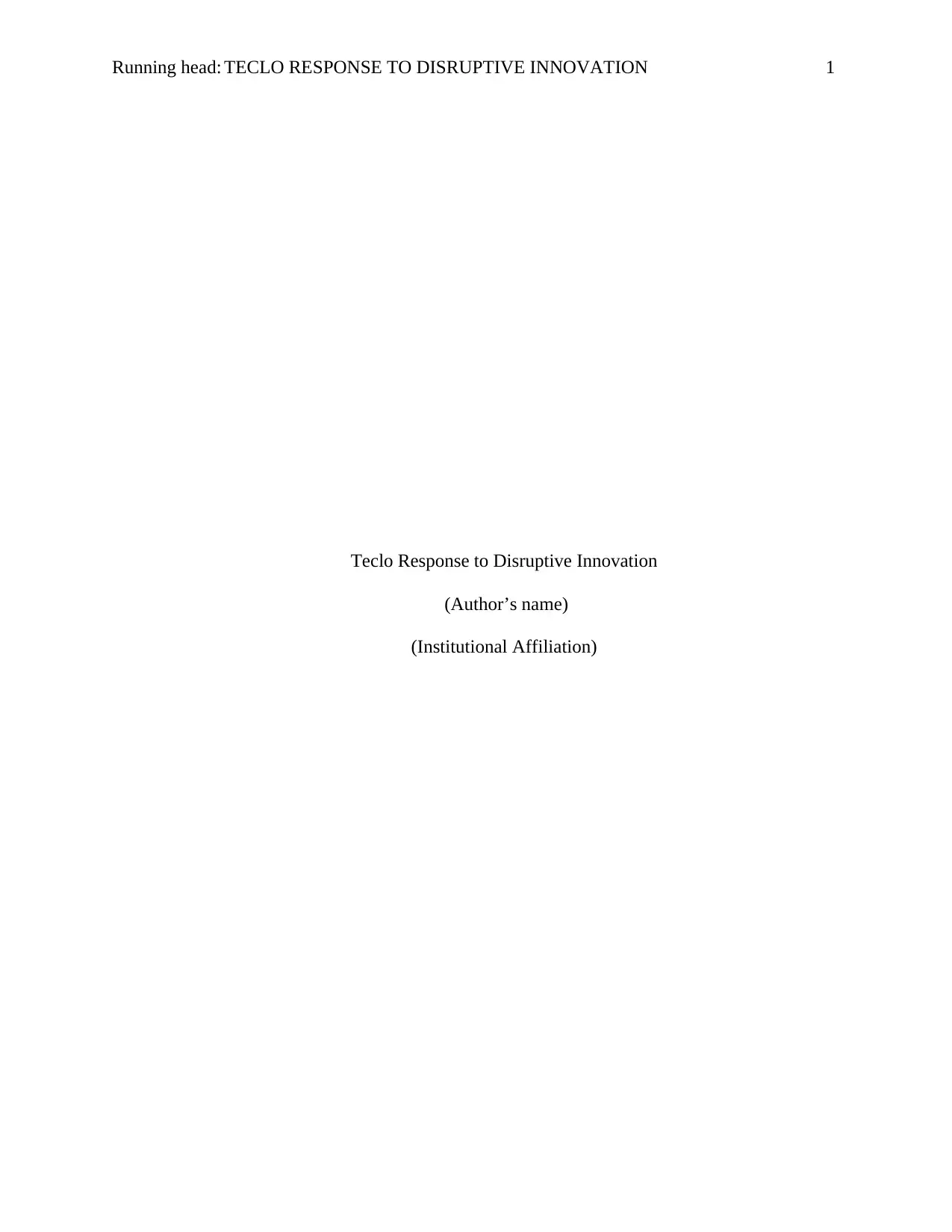
Running head: TECLO RESPONSE TO DISRUPTIVE INNOVATION 1
Teclo Response to Disruptive Innovation
(Author’s name)
(Institutional Affiliation)
Teclo Response to Disruptive Innovation
(Author’s name)
(Institutional Affiliation)
Paraphrase This Document
Need a fresh take? Get an instant paraphrase of this document with our AI Paraphraser
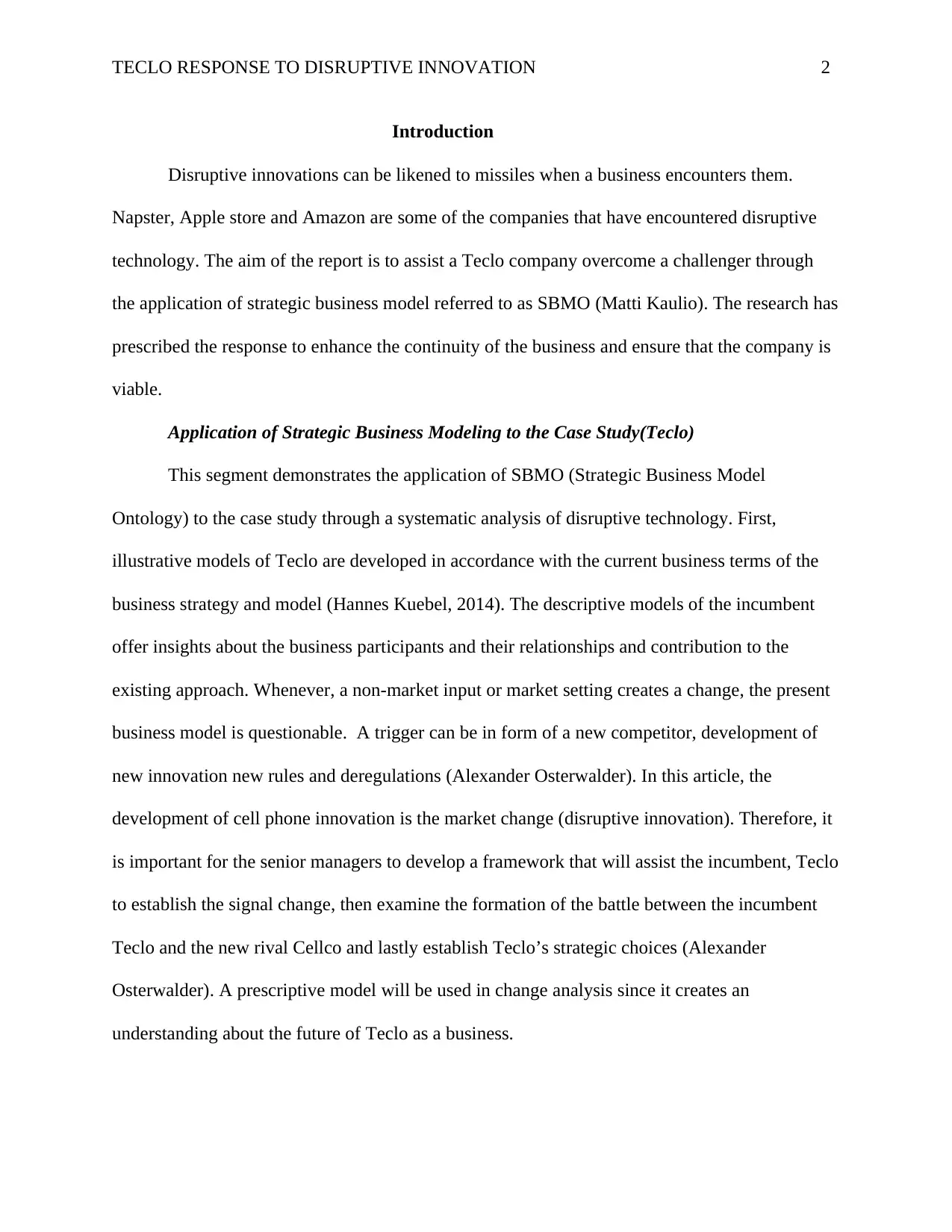
TECLO RESPONSE TO DISRUPTIVE INNOVATION 2
Introduction
Disruptive innovations can be likened to missiles when a business encounters them.
Napster, Apple store and Amazon are some of the companies that have encountered disruptive
technology. The aim of the report is to assist a Teclo company overcome a challenger through
the application of strategic business model referred to as SBMO (Matti Kaulio). The research has
prescribed the response to enhance the continuity of the business and ensure that the company is
viable.
Application of Strategic Business Modeling to the Case Study(Teclo)
This segment demonstrates the application of SBMO (Strategic Business Model
Ontology) to the case study through a systematic analysis of disruptive technology. First,
illustrative models of Teclo are developed in accordance with the current business terms of the
business strategy and model (Hannes Kuebel, 2014). The descriptive models of the incumbent
offer insights about the business participants and their relationships and contribution to the
existing approach. Whenever, a non-market input or market setting creates a change, the present
business model is questionable. A trigger can be in form of a new competitor, development of
new innovation new rules and deregulations (Alexander Osterwalder). In this article, the
development of cell phone innovation is the market change (disruptive innovation). Therefore, it
is important for the senior managers to develop a framework that will assist the incumbent, Teclo
to establish the signal change, then examine the formation of the battle between the incumbent
Teclo and the new rival Cellco and lastly establish Teclo’s strategic choices (Alexander
Osterwalder). A prescriptive model will be used in change analysis since it creates an
understanding about the future of Teclo as a business.
Introduction
Disruptive innovations can be likened to missiles when a business encounters them.
Napster, Apple store and Amazon are some of the companies that have encountered disruptive
technology. The aim of the report is to assist a Teclo company overcome a challenger through
the application of strategic business model referred to as SBMO (Matti Kaulio). The research has
prescribed the response to enhance the continuity of the business and ensure that the company is
viable.
Application of Strategic Business Modeling to the Case Study(Teclo)
This segment demonstrates the application of SBMO (Strategic Business Model
Ontology) to the case study through a systematic analysis of disruptive technology. First,
illustrative models of Teclo are developed in accordance with the current business terms of the
business strategy and model (Hannes Kuebel, 2014). The descriptive models of the incumbent
offer insights about the business participants and their relationships and contribution to the
existing approach. Whenever, a non-market input or market setting creates a change, the present
business model is questionable. A trigger can be in form of a new competitor, development of
new innovation new rules and deregulations (Alexander Osterwalder). In this article, the
development of cell phone innovation is the market change (disruptive innovation). Therefore, it
is important for the senior managers to develop a framework that will assist the incumbent, Teclo
to establish the signal change, then examine the formation of the battle between the incumbent
Teclo and the new rival Cellco and lastly establish Teclo’s strategic choices (Alexander
Osterwalder). A prescriptive model will be used in change analysis since it creates an
understanding about the future of Teclo as a business.
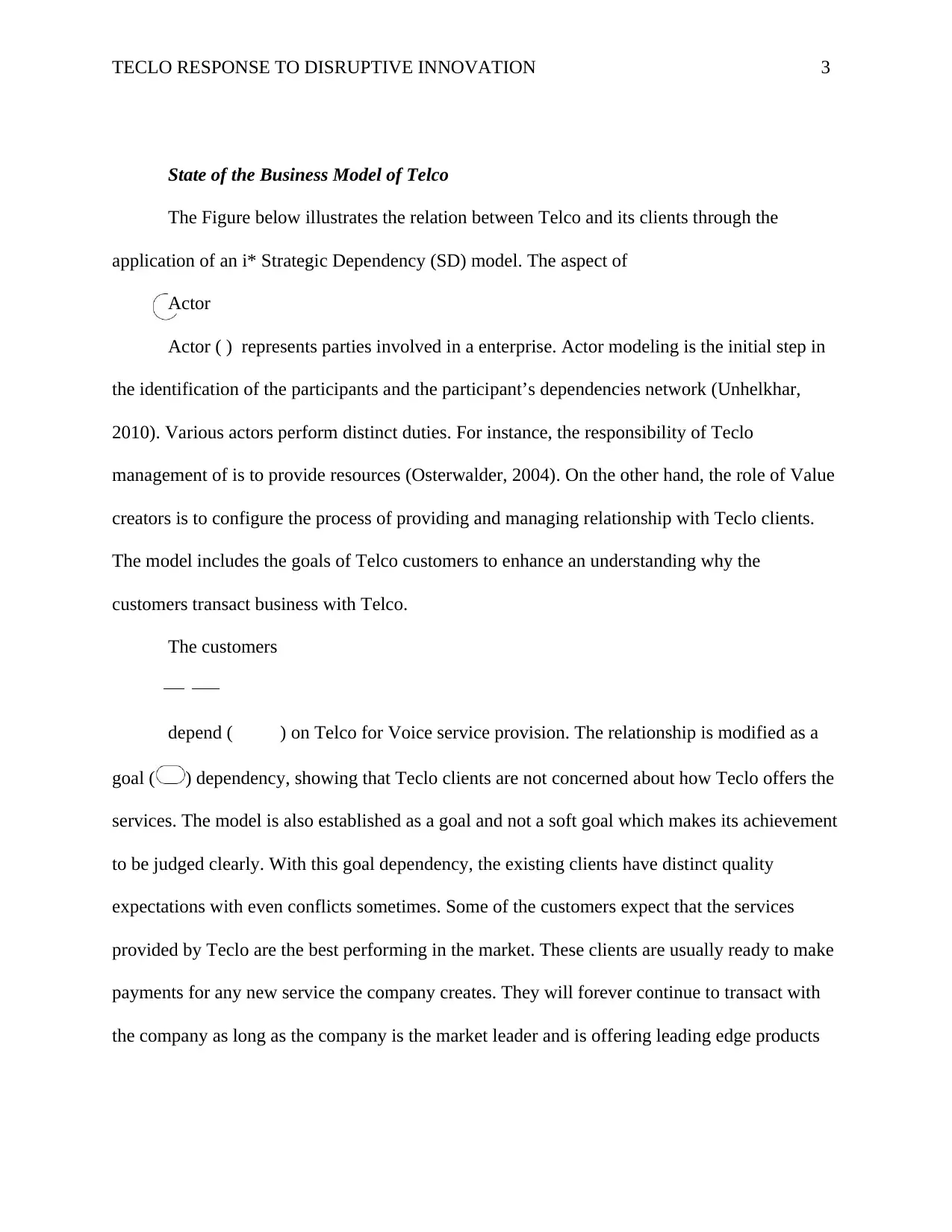
TECLO RESPONSE TO DISRUPTIVE INNOVATION 3
State of the Business Model of Telco
The Figure below illustrates the relation between Telco and its clients through the
application of an i* Strategic Dependency (SD) model. The aspect of
Actor
Actor ( ) represents parties involved in a enterprise. Actor modeling is the initial step in
the identification of the participants and the participant’s dependencies network (Unhelkhar,
2010). Various actors perform distinct duties. For instance, the responsibility of Teclo
management of is to provide resources (Osterwalder, 2004). On the other hand, the role of Value
creators is to configure the process of providing and managing relationship with Teclo clients.
The model includes the goals of Telco customers to enhance an understanding why the
customers transact business with Telco.
The customers
depend ( ) on Telco for Voice service provision. The relationship is modified as a
goal ( ) dependency, showing that Teclo clients are not concerned about how Teclo offers the
services. The model is also established as a goal and not a soft goal which makes its achievement
to be judged clearly. With this goal dependency, the existing clients have distinct quality
expectations with even conflicts sometimes. Some of the customers expect that the services
provided by Teclo are the best performing in the market. These clients are usually ready to make
payments for any new service the company creates. They will forever continue to transact with
the company as long as the company is the market leader and is offering leading edge products
State of the Business Model of Telco
The Figure below illustrates the relation between Telco and its clients through the
application of an i* Strategic Dependency (SD) model. The aspect of
Actor
Actor ( ) represents parties involved in a enterprise. Actor modeling is the initial step in
the identification of the participants and the participant’s dependencies network (Unhelkhar,
2010). Various actors perform distinct duties. For instance, the responsibility of Teclo
management of is to provide resources (Osterwalder, 2004). On the other hand, the role of Value
creators is to configure the process of providing and managing relationship with Teclo clients.
The model includes the goals of Telco customers to enhance an understanding why the
customers transact business with Telco.
The customers
depend ( ) on Telco for Voice service provision. The relationship is modified as a
goal ( ) dependency, showing that Teclo clients are not concerned about how Teclo offers the
services. The model is also established as a goal and not a soft goal which makes its achievement
to be judged clearly. With this goal dependency, the existing clients have distinct quality
expectations with even conflicts sometimes. Some of the customers expect that the services
provided by Teclo are the best performing in the market. These clients are usually ready to make
payments for any new service the company creates. They will forever continue to transact with
the company as long as the company is the market leader and is offering leading edge products
⊘ This is a preview!⊘
Do you want full access?
Subscribe today to unlock all pages.

Trusted by 1+ million students worldwide
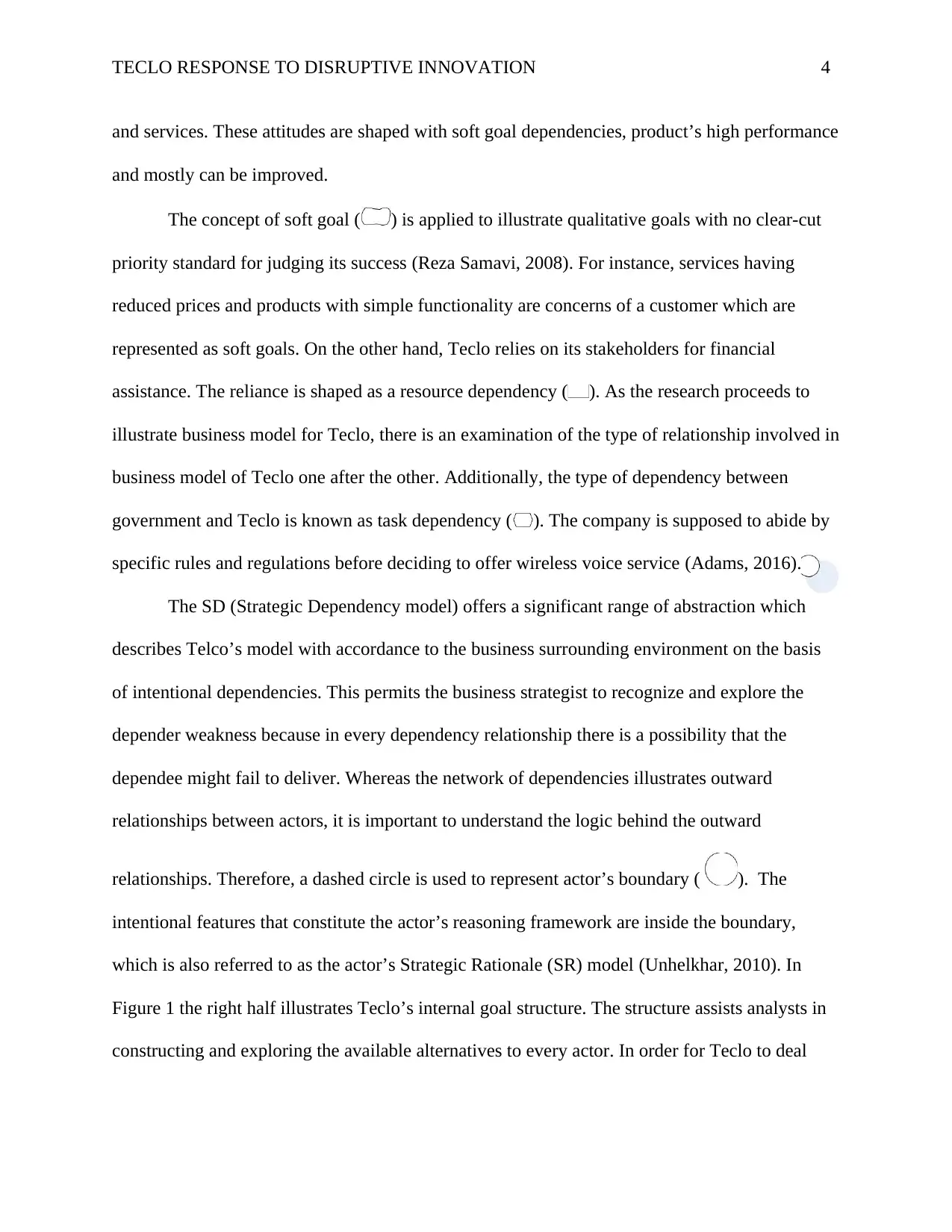
TECLO RESPONSE TO DISRUPTIVE INNOVATION 4
and services. These attitudes are shaped with soft goal dependencies, product’s high performance
and mostly can be improved.
The concept of soft goal ( ) is applied to illustrate qualitative goals with no clear-cut
priority standard for judging its success (Reza Samavi, 2008). For instance, services having
reduced prices and products with simple functionality are concerns of a customer which are
represented as soft goals. On the other hand, Teclo relies on its stakeholders for financial
assistance. The reliance is shaped as a resource dependency ( ). As the research proceeds to
illustrate business model for Teclo, there is an examination of the type of relationship involved in
business model of Teclo one after the other. Additionally, the type of dependency between
government and Teclo is known as task dependency ( ). The company is supposed to abide by
specific rules and regulations before deciding to offer wireless voice service (Adams, 2016).
The SD (Strategic Dependency model) offers a significant range of abstraction which
describes Telco’s model with accordance to the business surrounding environment on the basis
of intentional dependencies. This permits the business strategist to recognize and explore the
depender weakness because in every dependency relationship there is a possibility that the
dependee might fail to deliver. Whereas the network of dependencies illustrates outward
relationships between actors, it is important to understand the logic behind the outward
relationships. Therefore, a dashed circle is used to represent actor’s boundary ( ). The
intentional features that constitute the actor’s reasoning framework are inside the boundary,
which is also referred to as the actor’s Strategic Rationale (SR) model (Unhelkhar, 2010). In
Figure 1 the right half illustrates Teclo’s internal goal structure. The structure assists analysts in
constructing and exploring the available alternatives to every actor. In order for Teclo to deal
and services. These attitudes are shaped with soft goal dependencies, product’s high performance
and mostly can be improved.
The concept of soft goal ( ) is applied to illustrate qualitative goals with no clear-cut
priority standard for judging its success (Reza Samavi, 2008). For instance, services having
reduced prices and products with simple functionality are concerns of a customer which are
represented as soft goals. On the other hand, Teclo relies on its stakeholders for financial
assistance. The reliance is shaped as a resource dependency ( ). As the research proceeds to
illustrate business model for Teclo, there is an examination of the type of relationship involved in
business model of Teclo one after the other. Additionally, the type of dependency between
government and Teclo is known as task dependency ( ). The company is supposed to abide by
specific rules and regulations before deciding to offer wireless voice service (Adams, 2016).
The SD (Strategic Dependency model) offers a significant range of abstraction which
describes Telco’s model with accordance to the business surrounding environment on the basis
of intentional dependencies. This permits the business strategist to recognize and explore the
depender weakness because in every dependency relationship there is a possibility that the
dependee might fail to deliver. Whereas the network of dependencies illustrates outward
relationships between actors, it is important to understand the logic behind the outward
relationships. Therefore, a dashed circle is used to represent actor’s boundary ( ). The
intentional features that constitute the actor’s reasoning framework are inside the boundary,
which is also referred to as the actor’s Strategic Rationale (SR) model (Unhelkhar, 2010). In
Figure 1 the right half illustrates Teclo’s internal goal structure. The structure assists analysts in
constructing and exploring the available alternatives to every actor. In order for Teclo to deal
Paraphrase This Document
Need a fresh take? Get an instant paraphrase of this document with our AI Paraphraser
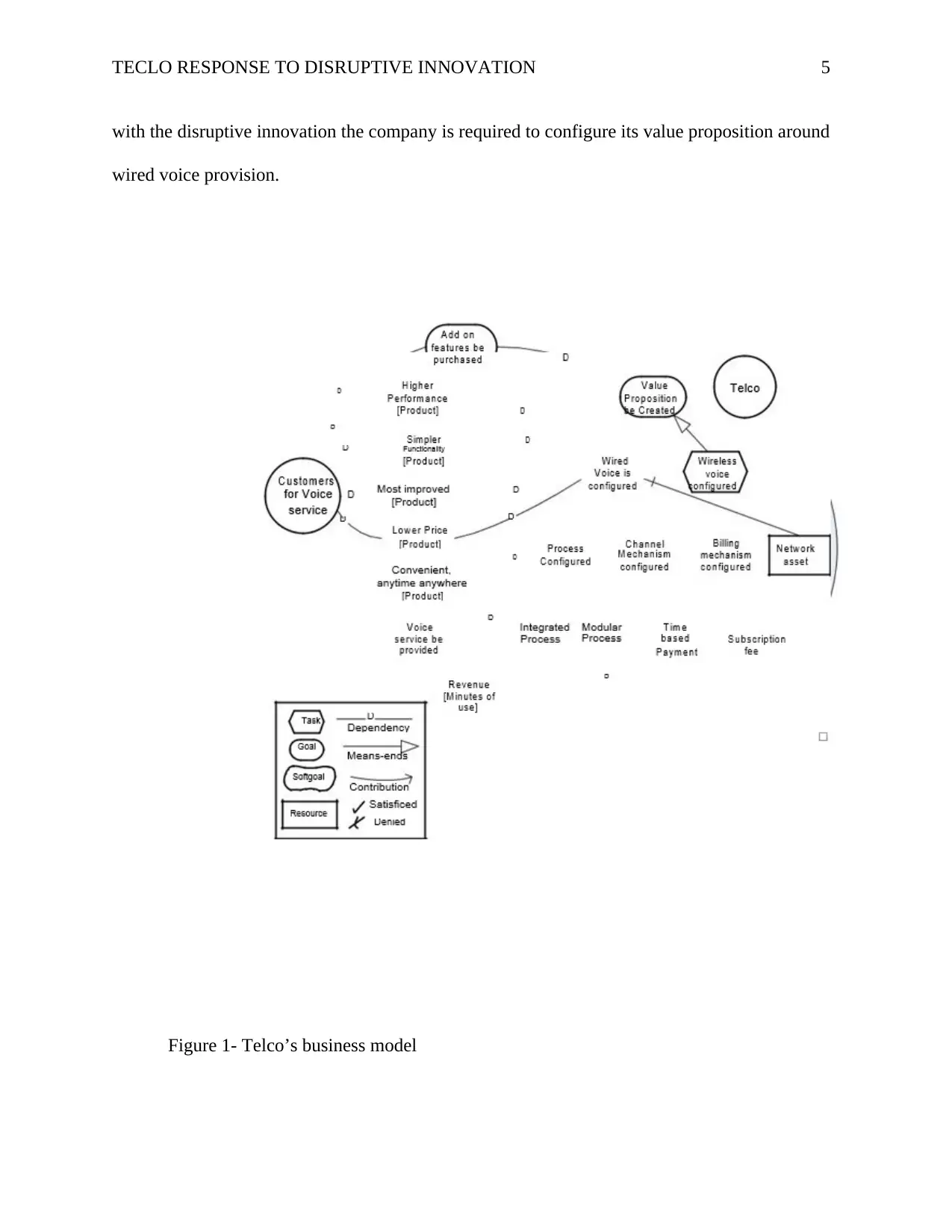
TECLO RESPONSE TO DISRUPTIVE INNOVATION 5
with the disruptive innovation the company is required to configure its value proposition around
wired voice provision.
Figure 1- Telco’s business model
with the disruptive innovation the company is required to configure its value proposition around
wired voice provision.
Figure 1- Telco’s business model
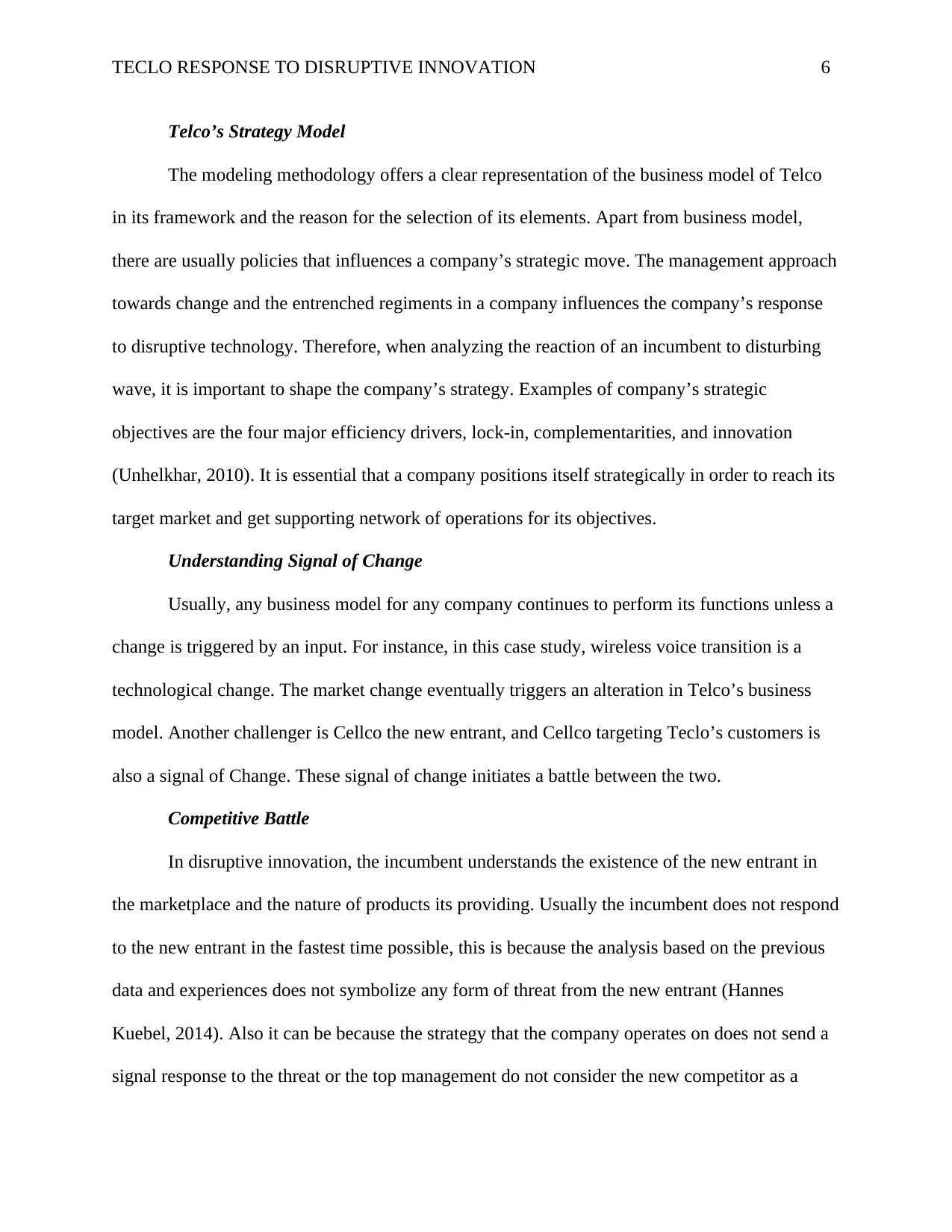
TECLO RESPONSE TO DISRUPTIVE INNOVATION 6
Telco’s Strategy Model
The modeling methodology offers a clear representation of the business model of Telco
in its framework and the reason for the selection of its elements. Apart from business model,
there are usually policies that influences a company’s strategic move. The management approach
towards change and the entrenched regiments in a company influences the company’s response
to disruptive technology. Therefore, when analyzing the reaction of an incumbent to disturbing
wave, it is important to shape the company’s strategy. Examples of company’s strategic
objectives are the four major efficiency drivers, lock-in, complementarities, and innovation
(Unhelkhar, 2010). It is essential that a company positions itself strategically in order to reach its
target market and get supporting network of operations for its objectives.
Understanding Signal of Change
Usually, any business model for any company continues to perform its functions unless a
change is triggered by an input. For instance, in this case study, wireless voice transition is a
technological change. The market change eventually triggers an alteration in Telco’s business
model. Another challenger is Cellco the new entrant, and Cellco targeting Teclo’s customers is
also a signal of Change. These signal of change initiates a battle between the two.
Competitive Battle
In disruptive innovation, the incumbent understands the existence of the new entrant in
the marketplace and the nature of products its providing. Usually the incumbent does not respond
to the new entrant in the fastest time possible, this is because the analysis based on the previous
data and experiences does not symbolize any form of threat from the new entrant (Hannes
Kuebel, 2014). Also it can be because the strategy that the company operates on does not send a
signal response to the threat or the top management do not consider the new competitor as a
Telco’s Strategy Model
The modeling methodology offers a clear representation of the business model of Telco
in its framework and the reason for the selection of its elements. Apart from business model,
there are usually policies that influences a company’s strategic move. The management approach
towards change and the entrenched regiments in a company influences the company’s response
to disruptive technology. Therefore, when analyzing the reaction of an incumbent to disturbing
wave, it is important to shape the company’s strategy. Examples of company’s strategic
objectives are the four major efficiency drivers, lock-in, complementarities, and innovation
(Unhelkhar, 2010). It is essential that a company positions itself strategically in order to reach its
target market and get supporting network of operations for its objectives.
Understanding Signal of Change
Usually, any business model for any company continues to perform its functions unless a
change is triggered by an input. For instance, in this case study, wireless voice transition is a
technological change. The market change eventually triggers an alteration in Telco’s business
model. Another challenger is Cellco the new entrant, and Cellco targeting Teclo’s customers is
also a signal of Change. These signal of change initiates a battle between the two.
Competitive Battle
In disruptive innovation, the incumbent understands the existence of the new entrant in
the marketplace and the nature of products its providing. Usually the incumbent does not respond
to the new entrant in the fastest time possible, this is because the analysis based on the previous
data and experiences does not symbolize any form of threat from the new entrant (Hannes
Kuebel, 2014). Also it can be because the strategy that the company operates on does not send a
signal response to the threat or the top management do not consider the new competitor as a
⊘ This is a preview!⊘
Do you want full access?
Subscribe today to unlock all pages.

Trusted by 1+ million students worldwide
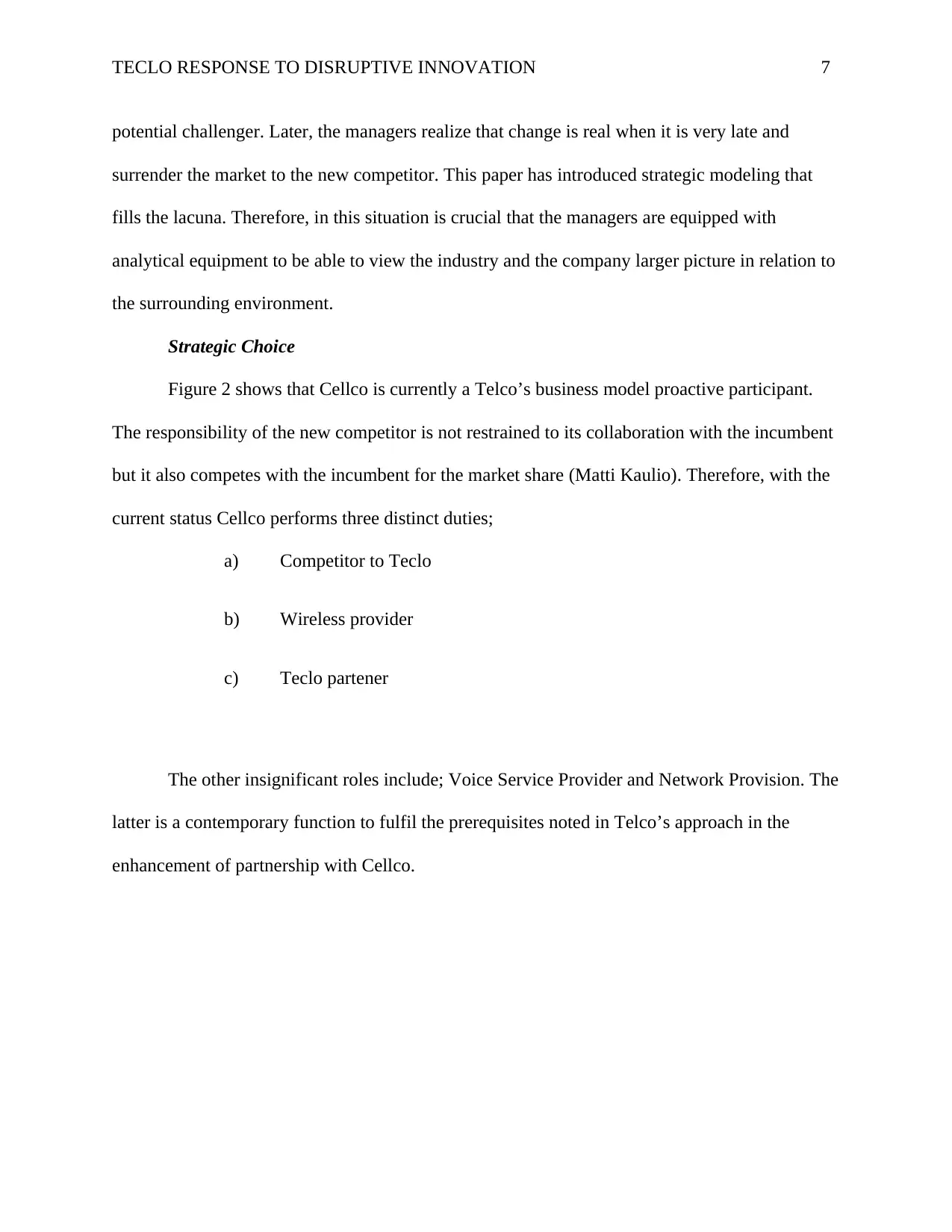
TECLO RESPONSE TO DISRUPTIVE INNOVATION 7
potential challenger. Later, the managers realize that change is real when it is very late and
surrender the market to the new competitor. This paper has introduced strategic modeling that
fills the lacuna. Therefore, in this situation is crucial that the managers are equipped with
analytical equipment to be able to view the industry and the company larger picture in relation to
the surrounding environment.
Strategic Choice
Figure 2 shows that Cellco is currently a Telco’s business model proactive participant.
The responsibility of the new competitor is not restrained to its collaboration with the incumbent
but it also competes with the incumbent for the market share (Matti Kaulio). Therefore, with the
current status Cellco performs three distinct duties;
a) Competitor to Teclo
b) Wireless provider
c) Teclo partener
The other insignificant roles include; Voice Service Provider and Network Provision. The
latter is a contemporary function to fulfil the prerequisites noted in Telco’s approach in the
enhancement of partnership with Cellco.
potential challenger. Later, the managers realize that change is real when it is very late and
surrender the market to the new competitor. This paper has introduced strategic modeling that
fills the lacuna. Therefore, in this situation is crucial that the managers are equipped with
analytical equipment to be able to view the industry and the company larger picture in relation to
the surrounding environment.
Strategic Choice
Figure 2 shows that Cellco is currently a Telco’s business model proactive participant.
The responsibility of the new competitor is not restrained to its collaboration with the incumbent
but it also competes with the incumbent for the market share (Matti Kaulio). Therefore, with the
current status Cellco performs three distinct duties;
a) Competitor to Teclo
b) Wireless provider
c) Teclo partener
The other insignificant roles include; Voice Service Provider and Network Provision. The
latter is a contemporary function to fulfil the prerequisites noted in Telco’s approach in the
enhancement of partnership with Cellco.
Paraphrase This Document
Need a fresh take? Get an instant paraphrase of this document with our AI Paraphraser
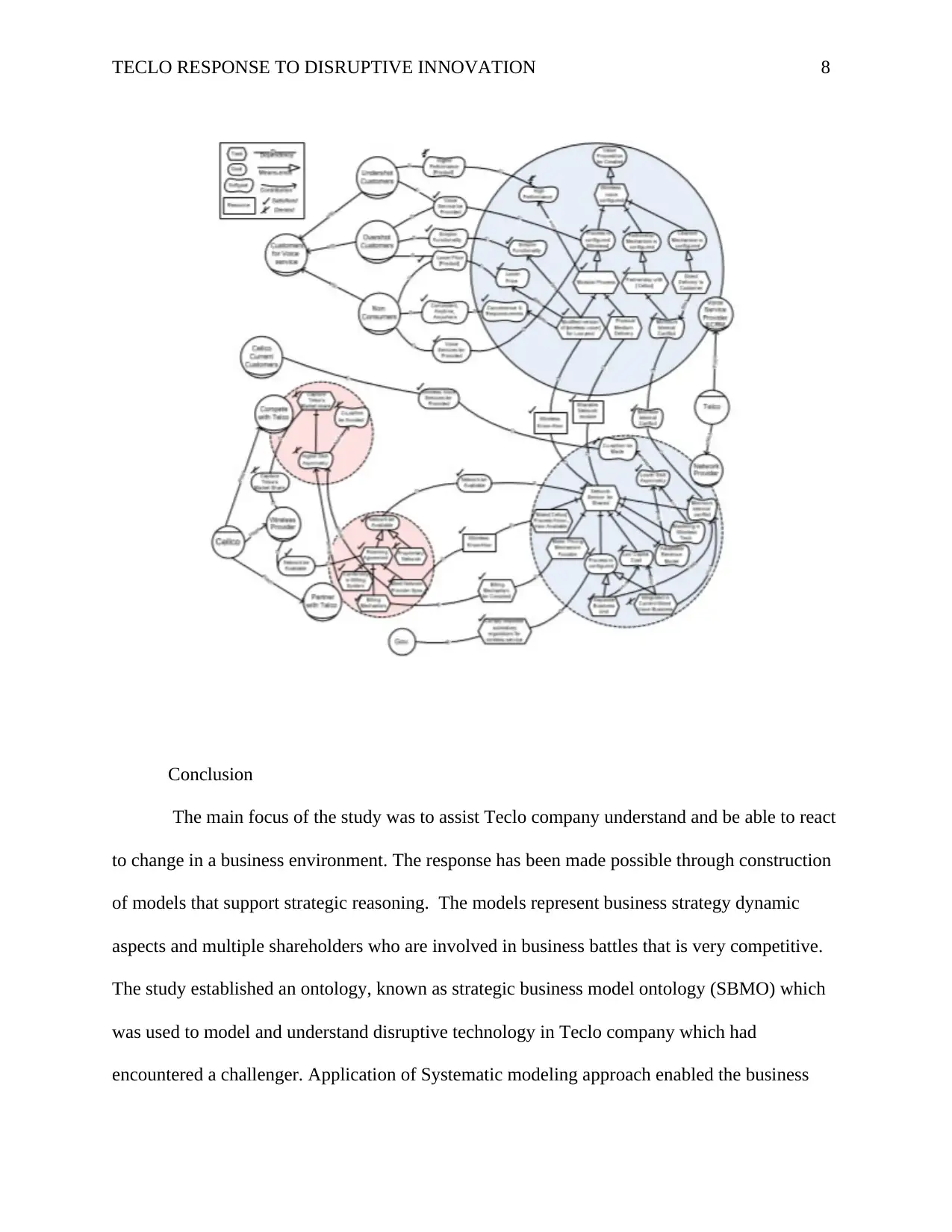
TECLO RESPONSE TO DISRUPTIVE INNOVATION 8
Conclusion
The main focus of the study was to assist Teclo company understand and be able to react
to change in a business environment. The response has been made possible through construction
of models that support strategic reasoning. The models represent business strategy dynamic
aspects and multiple shareholders who are involved in business battles that is very competitive.
The study established an ontology, known as strategic business model ontology (SBMO) which
was used to model and understand disruptive technology in Teclo company which had
encountered a challenger. Application of Systematic modeling approach enabled the business
Conclusion
The main focus of the study was to assist Teclo company understand and be able to react
to change in a business environment. The response has been made possible through construction
of models that support strategic reasoning. The models represent business strategy dynamic
aspects and multiple shareholders who are involved in business battles that is very competitive.
The study established an ontology, known as strategic business model ontology (SBMO) which
was used to model and understand disruptive technology in Teclo company which had
encountered a challenger. Application of Systematic modeling approach enabled the business
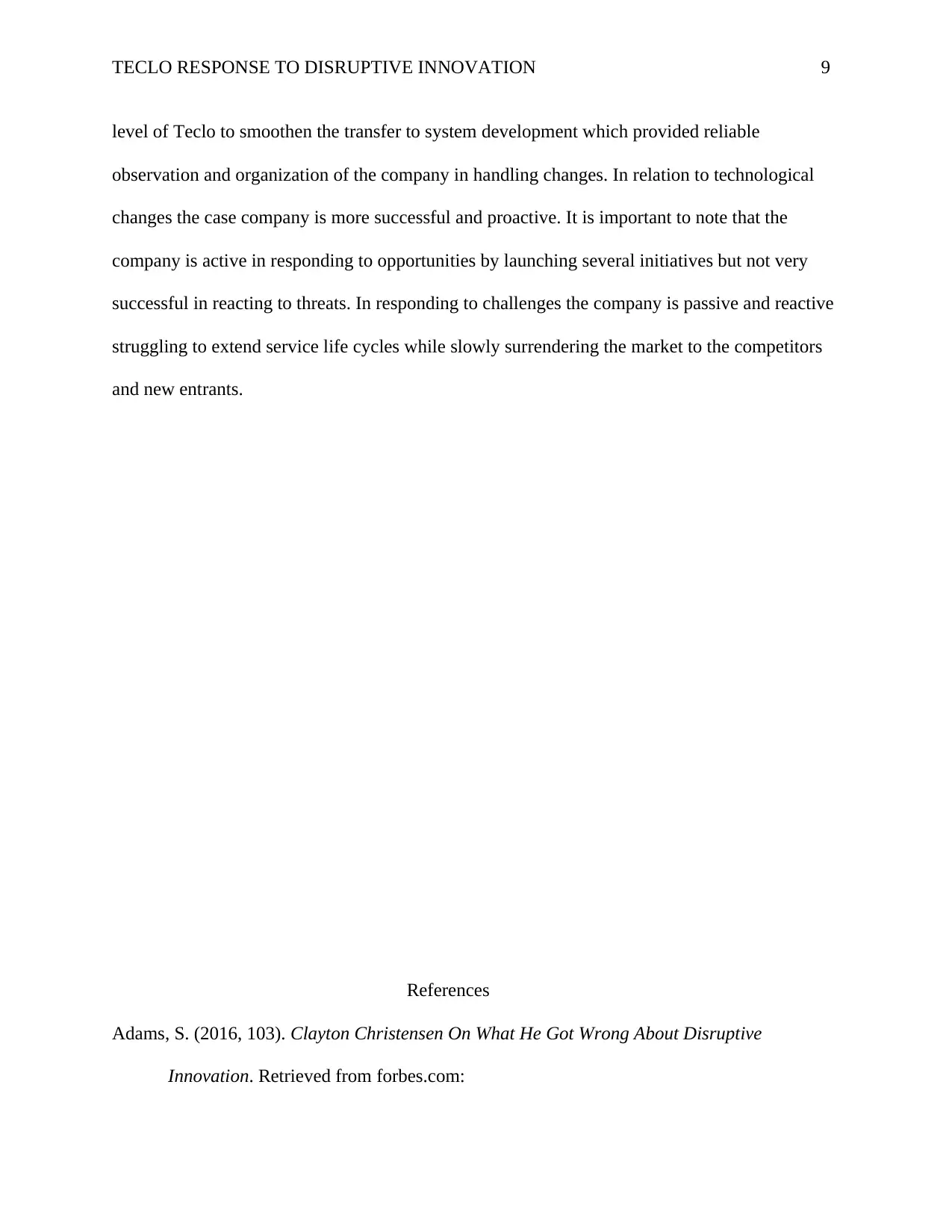
TECLO RESPONSE TO DISRUPTIVE INNOVATION 9
level of Teclo to smoothen the transfer to system development which provided reliable
observation and organization of the company in handling changes. In relation to technological
changes the case company is more successful and proactive. It is important to note that the
company is active in responding to opportunities by launching several initiatives but not very
successful in reacting to threats. In responding to challenges the company is passive and reactive
struggling to extend service life cycles while slowly surrendering the market to the competitors
and new entrants.
References
Adams, S. (2016, 103). Clayton Christensen On What He Got Wrong About Disruptive
Innovation. Retrieved from forbes.com:
level of Teclo to smoothen the transfer to system development which provided reliable
observation and organization of the company in handling changes. In relation to technological
changes the case company is more successful and proactive. It is important to note that the
company is active in responding to opportunities by launching several initiatives but not very
successful in reacting to threats. In responding to challenges the company is passive and reactive
struggling to extend service life cycles while slowly surrendering the market to the competitors
and new entrants.
References
Adams, S. (2016, 103). Clayton Christensen On What He Got Wrong About Disruptive
Innovation. Retrieved from forbes.com:
⊘ This is a preview!⊘
Do you want full access?
Subscribe today to unlock all pages.

Trusted by 1+ million students worldwide
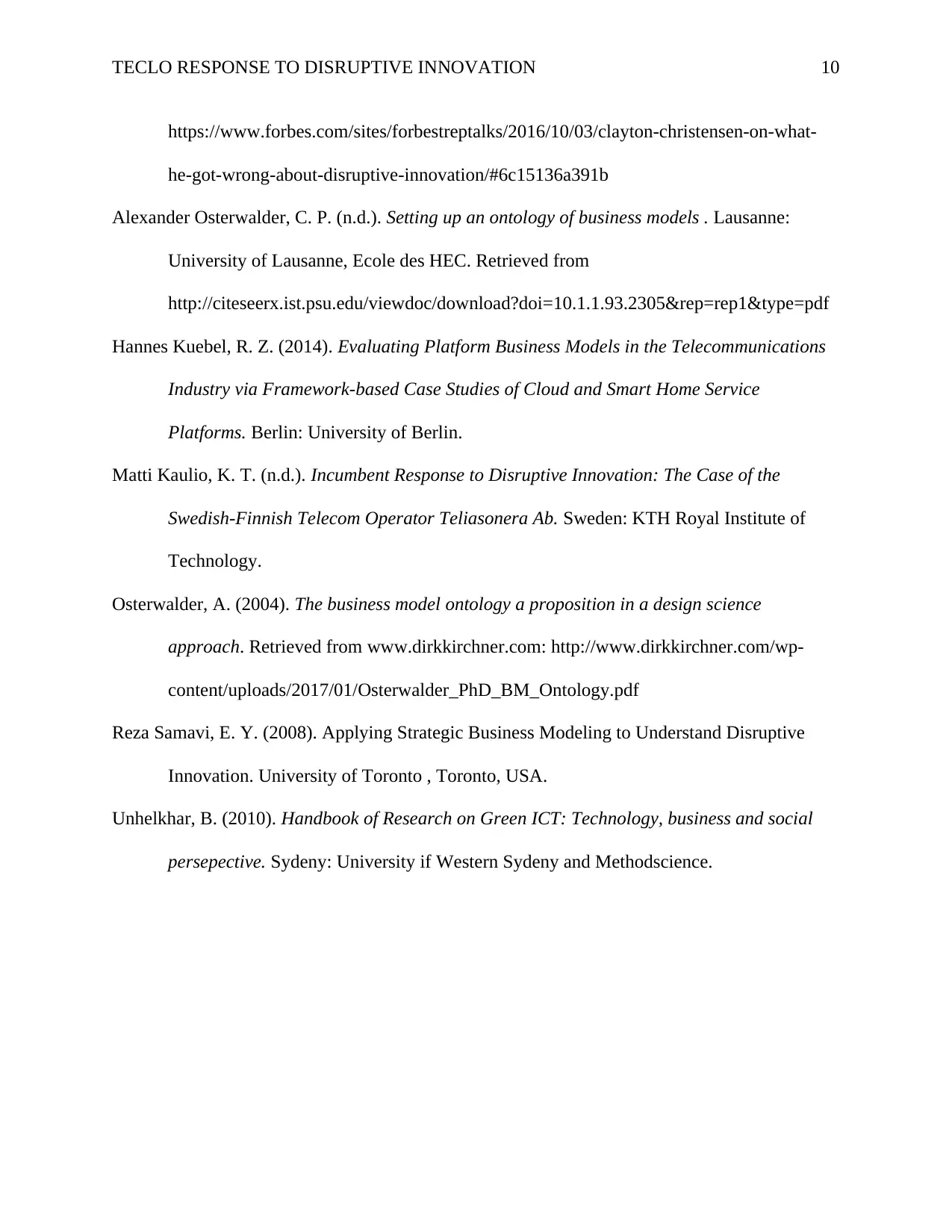
TECLO RESPONSE TO DISRUPTIVE INNOVATION 10
https://www.forbes.com/sites/forbestreptalks/2016/10/03/clayton-christensen-on-what-
he-got-wrong-about-disruptive-innovation/#6c15136a391b
Alexander Osterwalder, C. P. (n.d.). Setting up an ontology of business models . Lausanne:
University of Lausanne, Ecole des HEC. Retrieved from
http://citeseerx.ist.psu.edu/viewdoc/download?doi=10.1.1.93.2305&rep=rep1&type=pdf
Hannes Kuebel, R. Z. (2014). Evaluating Platform Business Models in the Telecommunications
Industry via Framework-based Case Studies of Cloud and Smart Home Service
Platforms. Berlin: University of Berlin.
Matti Kaulio, K. T. (n.d.). Incumbent Response to Disruptive Innovation: The Case of the
Swedish-Finnish Telecom Operator Teliasonera Ab. Sweden: KTH Royal Institute of
Technology.
Osterwalder, A. (2004). The business model ontology a proposition in a design science
approach. Retrieved from www.dirkkirchner.com: http://www.dirkkirchner.com/wp-
content/uploads/2017/01/Osterwalder_PhD_BM_Ontology.pdf
Reza Samavi, E. Y. (2008). Applying Strategic Business Modeling to Understand Disruptive
Innovation. University of Toronto , Toronto, USA.
Unhelkhar, B. (2010). Handbook of Research on Green ICT: Technology, business and social
persepective. Sydeny: University if Western Sydeny and Methodscience.
https://www.forbes.com/sites/forbestreptalks/2016/10/03/clayton-christensen-on-what-
he-got-wrong-about-disruptive-innovation/#6c15136a391b
Alexander Osterwalder, C. P. (n.d.). Setting up an ontology of business models . Lausanne:
University of Lausanne, Ecole des HEC. Retrieved from
http://citeseerx.ist.psu.edu/viewdoc/download?doi=10.1.1.93.2305&rep=rep1&type=pdf
Hannes Kuebel, R. Z. (2014). Evaluating Platform Business Models in the Telecommunications
Industry via Framework-based Case Studies of Cloud and Smart Home Service
Platforms. Berlin: University of Berlin.
Matti Kaulio, K. T. (n.d.). Incumbent Response to Disruptive Innovation: The Case of the
Swedish-Finnish Telecom Operator Teliasonera Ab. Sweden: KTH Royal Institute of
Technology.
Osterwalder, A. (2004). The business model ontology a proposition in a design science
approach. Retrieved from www.dirkkirchner.com: http://www.dirkkirchner.com/wp-
content/uploads/2017/01/Osterwalder_PhD_BM_Ontology.pdf
Reza Samavi, E. Y. (2008). Applying Strategic Business Modeling to Understand Disruptive
Innovation. University of Toronto , Toronto, USA.
Unhelkhar, B. (2010). Handbook of Research on Green ICT: Technology, business and social
persepective. Sydeny: University if Western Sydeny and Methodscience.
Paraphrase This Document
Need a fresh take? Get an instant paraphrase of this document with our AI Paraphraser
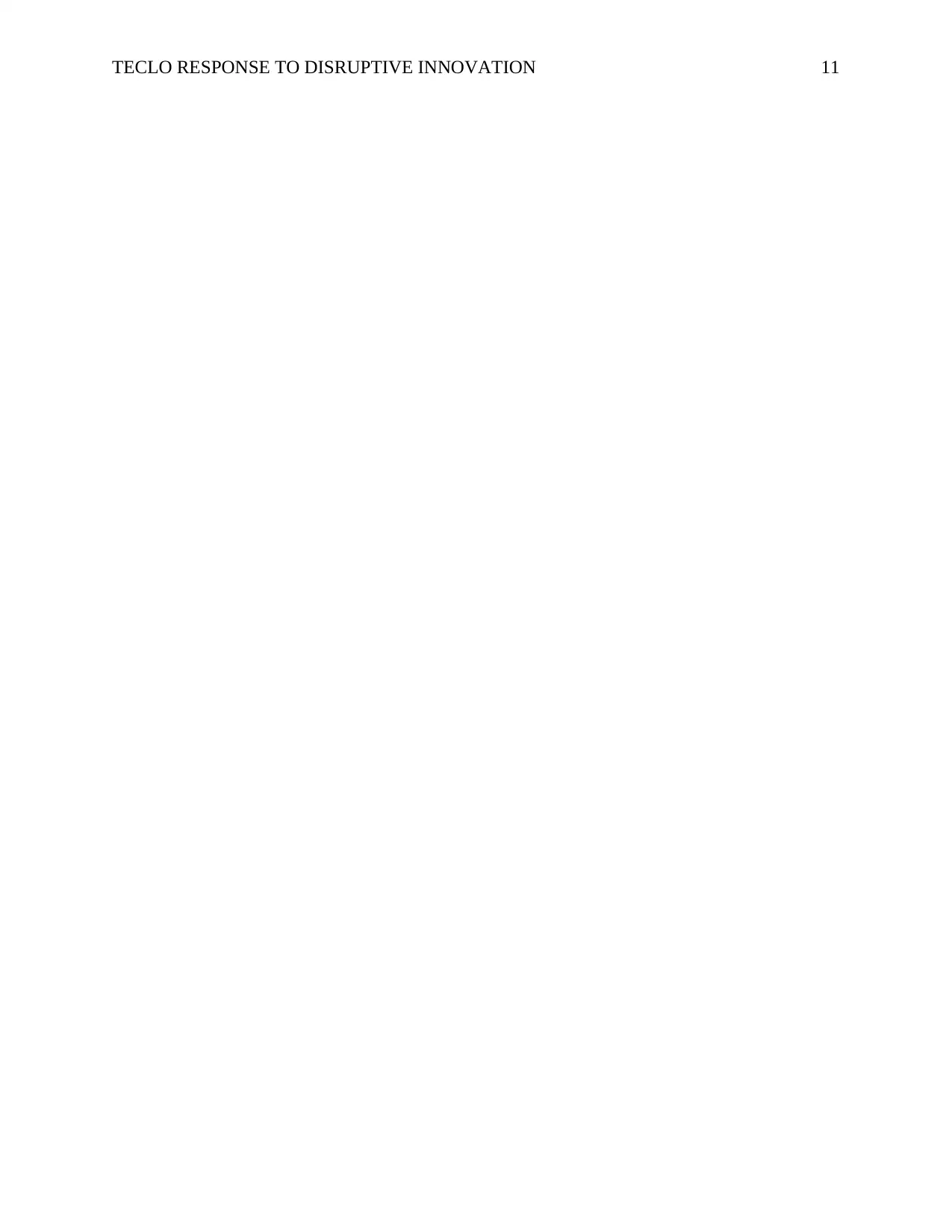
TECLO RESPONSE TO DISRUPTIVE INNOVATION 11
1 out of 11
Related Documents
Your All-in-One AI-Powered Toolkit for Academic Success.
+13062052269
info@desklib.com
Available 24*7 on WhatsApp / Email
![[object Object]](/_next/static/media/star-bottom.7253800d.svg)
Unlock your academic potential
Copyright © 2020–2025 A2Z Services. All Rights Reserved. Developed and managed by ZUCOL.




